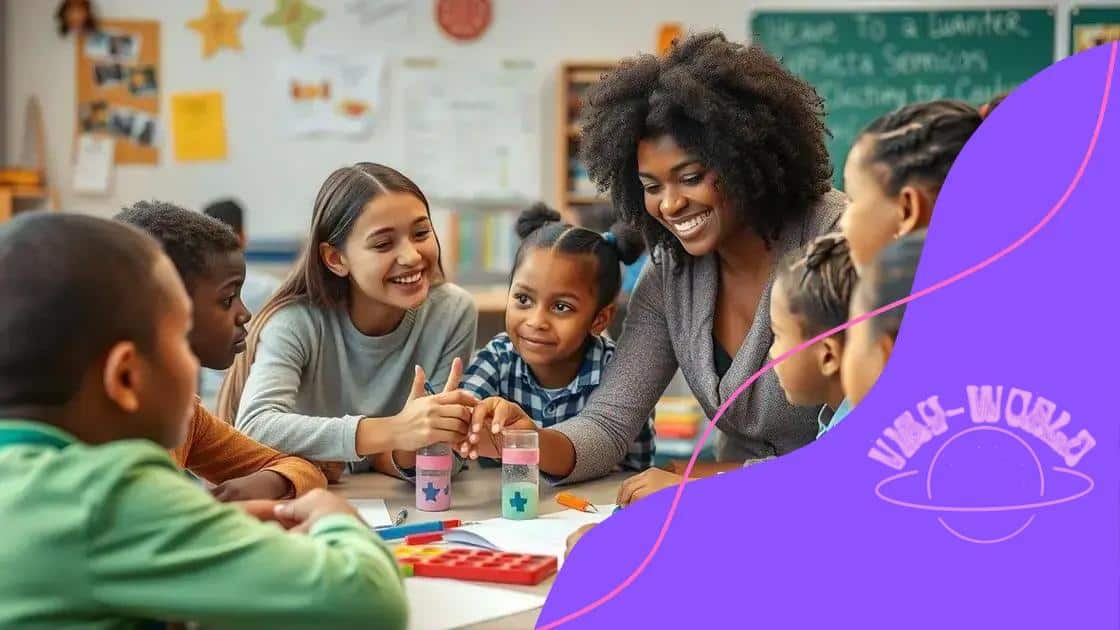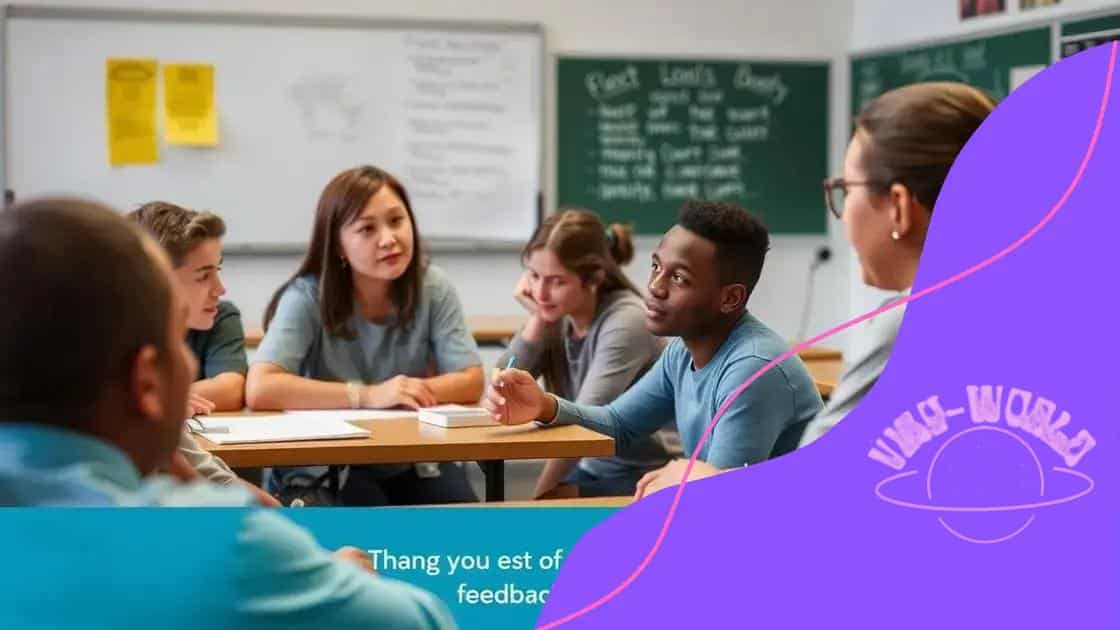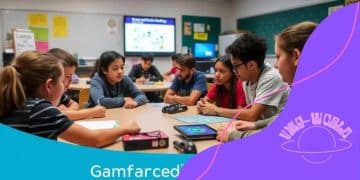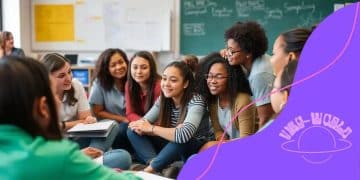Good teachers produce good students: secrets to success

Developing a growth mindset in students encourages them to view challenges as opportunities for growth, promotes perseverance, and is supported by effective mentorship and a collaborative, nurturing classroom environment.
Good teachers produce good students by creating an environment that embraces curiosity and active learning. Have you ever wondered how impactful teacher interactions can shape a student’s journey?
The impact of teacher engagement on student success
Teacher engagement plays a crucial role in student success. When teachers are enthusiastic and committed, students often mirror that attitude. This leads to a more vibrant and effective learning environment.
Why Engagement Matters
Engaged teachers create a classroom atmosphere that encourages students to participate actively. This participation enhances understanding and retention of knowledge. Various studies indicate that students perform better when their teachers are invested in their growth.
Key Benefits of Teacher Engagement
- Improved student motivation
- Greater academic achievement
- Enhanced classroom behavior
- Stronger student-teacher relationships
Moreover, when teachers show passion for their subjects, it captivates students’ interest. This leads to a cycle where motivated students seek out knowledge, contributing to a dynamic and productive classroom environment.
Teachers who participate in professional development are often more engaged. This not only helps them improve their teaching practices but also boosts their confidence. Stronger teaching skills lead to increased student engagement, creating a win-win situation for both parties.
Creating an Engaging Classroom
To promote teacher engagement, schools can implement supportive measures. Encouraging collaboration among teachers can lead to innovative teaching strategies.
- Provide opportunities for teamwork
- Encourage sharing of best practices
- Offer incentives for engaging teaching methods
As a result, active teacher engagement influences classroom dynamics positively. Ultimately, a teacher who is engaged makes learning enjoyable and impactful for their students.
Strategies for creating an interactive classroom
Creating an interactive classroom is essential for enhancing student learning and engagement. Interactive classrooms encourage participation and collaboration, making learning a more dynamic experience.
Build a Strong Community
Establishing a classroom community lays the foundation for interaction. When students feel safe and supported, they are more likely to share ideas and take risks. This sense of belonging can foster a positive atmosphere conducive to learning.
Incorporate Technology
Technology can greatly enhance classroom interaction. Using tools like interactive whiteboards and online collaboration platforms allows students to engage with the material in fresh, exciting ways.
- Use educational apps to facilitate group projects
- Incorporate online quizzes to encourage participation
- Utilize video conferencing for guest speakers
By integrating technology, teachers can make lessons more engaging and relevant to today’s digital learners. This not only holds students’ attention but also prepares them for a tech-savvy world.
Encourage Group Activities
Group activities are a fantastic way to boost interaction. When students work together, they develop teamwork skills and learn to value different perspectives. Activities like debates, role-plays, and project-based learning can spark interest and discussion.
- Organize debates on current topics
- Create role-play scenarios for learning
- Implement project-based learning opportunities
These methods push students to engage creatively with their peers and the subject matter. As a result, learning becomes more meaningful and memorable.
Another effective strategy involves using question-and-answer sessions during lessons. Allowing time for questions not only clarifies misunderstandings but also fosters critical thinking. It encourages students to express their thoughts and dive deeper into the material.
How feedback shapes student growth

Feedback is a powerful tool that significantly influences student growth. Effective feedback helps students understand their strengths and areas for improvement. When teachers provide specific feedback, learners can adjust their study habits and strategies.
Types of Feedback
There are various types of feedback that can benefit students. Each type plays a unique role in the learning process, helping to shape student performance and motivation.
- Positive Feedback: Reinforces good practices and boosts confidence.
- Constructive Criticism: Highlights areas for improvement while suggesting ways to achieve that.
- Peer Feedback: Allows students to learn from each other, making the process collaborative.
Students often respond better to feedback when it includes actionable advice. For instance, instead of just saying a project is good, teachers should specify what exactly makes it good. This supports students in replicating success in future assignments.
Implementing Feedback in the Classroom
To foster growth, teachers can create a feedback-rich environment. Regular check-ins and interactive discussions can encourage students to seek and receive feedback openly. This practice helps build a growth mindset, where students view challenges as opportunities for learning.
Additionally, encouraging self-reflection can be a powerful feedback mechanism. When students assess their work, they cultivate independent learning skills. For example, after completing an assignment, students might ask themselves questions like, “What did I do well?” and “What can I improve?” This self-inquiry grows their capacity for critical thinking.
Feedback and Motivation
Incorporating feedback into the learning process can enhance student motivation. When educators highlight progress and celebrate achievements, it fosters a sense of accomplishment. Acknowledging effort, no matter how small, keeps students engaged and eager to improve.
- Set specific, measurable goals for students.
- Provide timely feedback to help them stay on track.
- Encourage them to set personal learning goals based on feedback received.
Overall, feedback serves as a foundational element in education. By integrating it into daily routines, teachers can significantly impact student growth and success.
The role of mentorship in education
Mentorship plays a vital role in education, significantly impacting student development and success. Effective mentorship helps guide students through academic challenges and provides them with support in their personal growth.
Benefits of Mentorship
Mentorship offers numerous advantages for students. When students have mentors, they receive valuable insights and encouragement that can motivate them to achieve their goals.
- Personalized Guidance: Mentors can tailor their advice based on individual student needs.
- Emotional Support: Having a mentor helps students navigate their feelings and challenges.
- Networking Opportunities: Mentors can connect students with valuable resources and contacts.
In addition, mentors play a crucial role in helping students set and reach academic and career goals. With their experience and knowledge, mentors can offer advice on how to overcome obstacles and seize opportunities.
Creating Strong Mentoring Relationships
To foster effective mentorship, it is essential to build strong relationships between mentors and mentees. Trust and open communication are the foundations of these relationships. When students feel comfortable sharing their thoughts, mentors can better support their growth.
Regular meetings can enhance this relationship. Whether in person or online, consistent interaction helps mentors understand their mentees’ evolving needs. This ensures that the guidance remains relevant and impactful.
Encouraging Peer Mentorship
Peer mentorship is another effective approach in education. Senior students can act as mentors to their juniors, sharing insights and experiences. This dynamic fosters a sense of community and encourages collaboration.
- Promotes leadership skills among older students.
- Strengthens connections within the school community.
- Provides fresh perspectives for younger students.
Involving students in mentorship roles empowers them and creates an inclusive learning environment. Everyone benefits from the shared knowledge and support, leading to positive educational experiences.
Developing a growth mindset in students
Developing a growth mindset in students is essential for their overall success. A growth mindset encourages students to view challenges as opportunities to learn and grow rather than obstacles to avoid. This positive outlook can have a significant impact on their academic and personal lives.
Understanding Growth Mindset
A growth mindset is the belief that abilities and intelligence can be developed with effort and dedication. Students with this mindset embrace challenges, persist in the face of setbacks, and see effort as a path to mastery. By fostering this attitude, educators can help students become more resilient and adaptable.
Strategies to Foster a Growth Mindset
Teachers can implement various strategies to promote a growth mindset in their classrooms. One effective method is to provide frequent, constructive feedback. This type of feedback focuses on the process of learning and reinforces the idea that mistakes are part of the journey.
- Encourage students to set personal learning goals.
- Highlight the importance of effort over innate ability.
- Model a growth mindset by sharing personal experiences.
Additionally, using language that emphasizes growth can help. For example, instead of saying, “You’re so smart,” teachers can say, “You worked really hard on this!” This shift in language directs attention to the effort put into the task, promoting a culture of learning.
Creating a Supportive Environment
A supportive classroom environment is critical for nurturing a growth mindset. Teachers can create a space where students feel safe to take risks and make mistakes. Encouraging collaboration and peer support allows students to learn from one another and build confidence.
Activities that focus on teamwork can significantly enhance this atmosphere. Educational games or group projects can teach students to rely on each other and share strategies for overcoming challenges. By emphasizing collaboration, students learn that they are not alone in their struggles.
Celebrating Effort and Progress
Finally, celebrating effort and progress is crucial in developing a growth mindset. Recognizing achievements, big or small, motivates students to keep working towards their goals. Consider implementing a reward system that highlights improvement, persistence, and teamwork.
- Host celebrations for academic milestones.
- Share success stories of students overcoming obstacles.
- Encourage reflection on personal growth over time.
By fostering a culture of growth, teachers can help students realize their potential and encourage lifelong learning.
In summary, fostering a growth mindset in students is crucial for their development and success. By encouraging challenges and celebrating effort, we can help them see the value in persistence. Providing personalized guidance and building a supportive environment creates opportunities for students to thrive. With effective mentorship and collaboration, we can instill the belief that they can improve and achieve their goals. Let’s commit to nurturing this mindset in every classroom!
FAQ – Questions about Developing a Growth Mindset in Students
What is a growth mindset?
A growth mindset is the belief that abilities and intelligence can be developed through effort and dedication.
How can teachers foster a growth mindset?
Teachers can foster a growth mindset by providing constructive feedback, encouraging goal setting, and celebrating effort and progress.
What role does mentorship play in developing a growth mindset?
Mentorship provides guidance and support that helps students navigate challenges and reinforces the belief that they can improve.
Why is a supportive environment important?
A supportive environment helps students feel safe to take risks, which encourages learning and personal growth.





